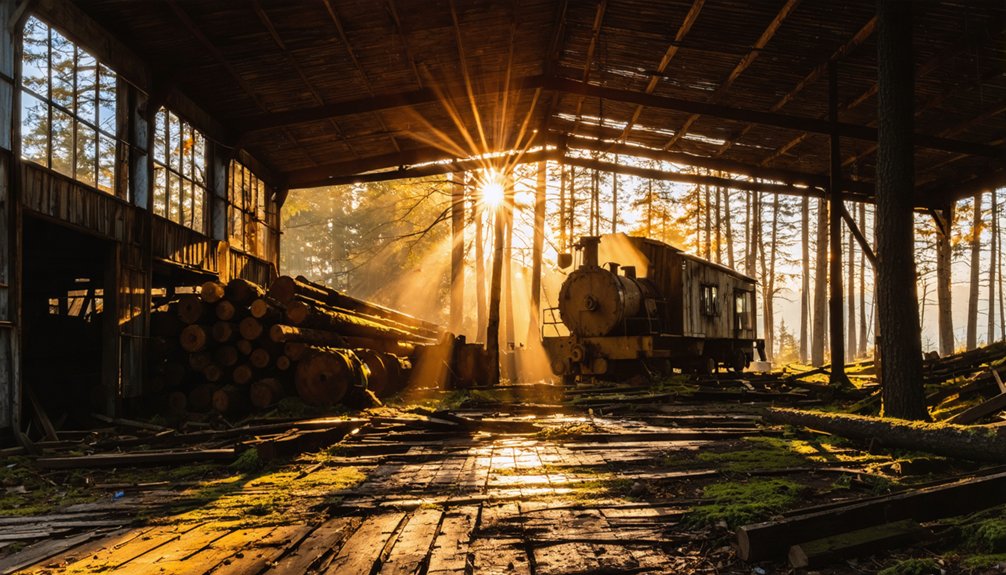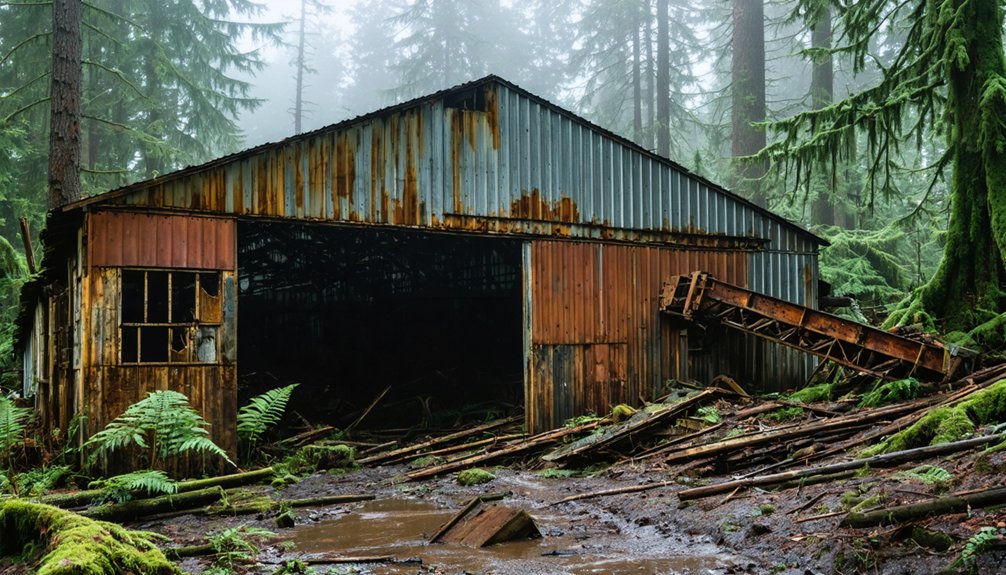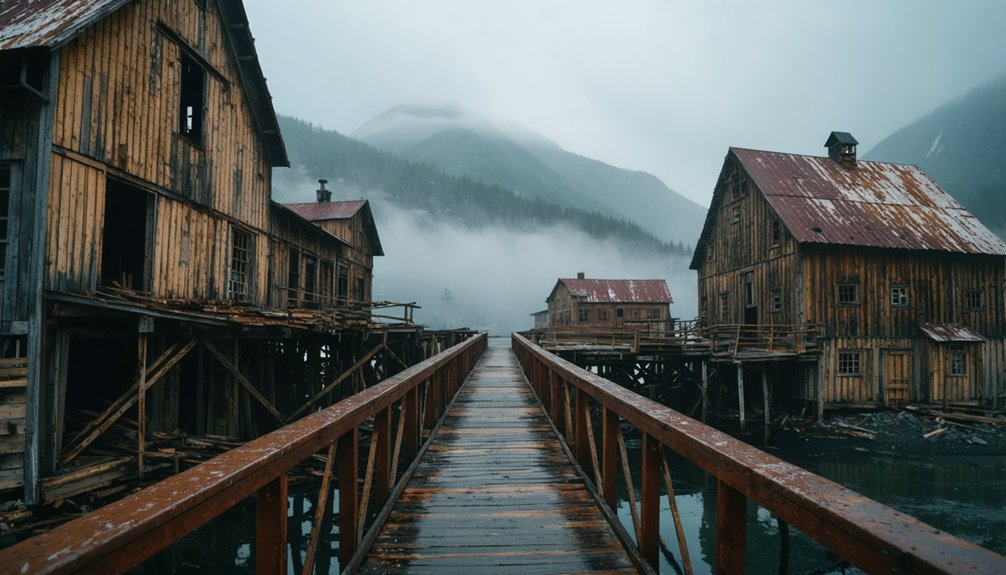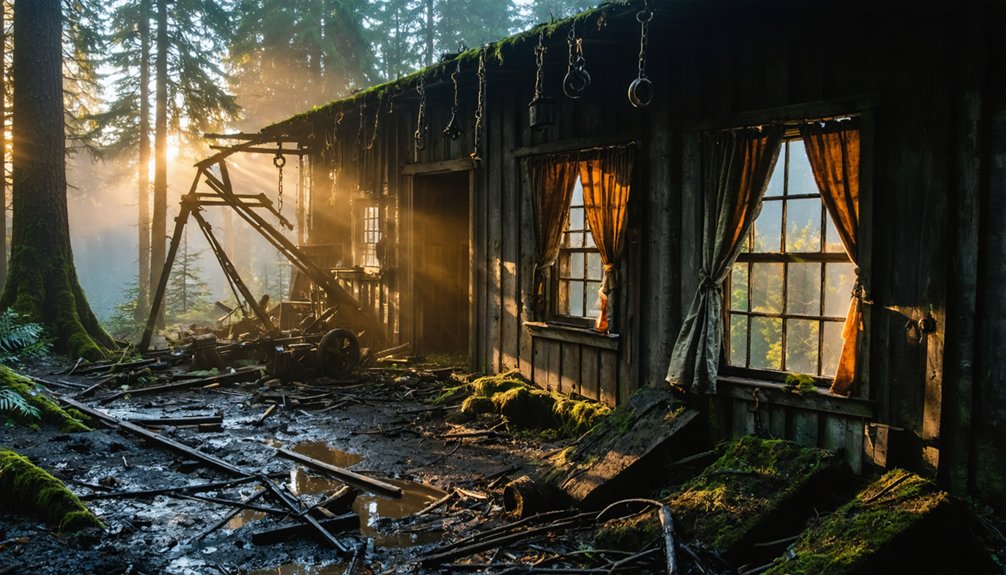You’ll find America’s most intriguing abandoned sawmill towns scattered across New Hampshire, including Livermore (1876-1951), Zealand Village (1880s), Johnson (early 1900s), Beebe River, and Carrigain. Additional ghost towns dot the landscapes of Louisiana (Fullerton), Michigan’s lumber settlements, Maine’s northern woods (Riceville), and Oregon’s forest sites. These once-bustling communities, home to thousands of workers, now stand as silent witnesses to America’s logging heritage, their remaining foundations and artifacts telling stories of industrial ambition.
Key Takeaways
- Livermore, New Hampshire was a thriving sawmill town of 200-300 residents until devastating fires and floods led to its dissolution in 1951.
- Zealand Village featured a powerful steam sawmill operation but declined after multiple fires and the depletion of local timber resources.
- Fullerton, Louisiana was a major timber town housing 5,000 residents before its closure in 1927, leaving only archaeological traces today.
- The Beebe River Mill Complex produced 100,000 board feet daily at its peak in 1917 before declining after an ownership change.
- Johnson supported a self-sufficient community with a post office and school until its abandonment in 1916 following a catastrophic mill fire.
Livermore, New Hampshire: A Lost White Mountain Community
While many lumber towns dotted New Hampshire’s White Mountains in the late 19th century, Livermore stood out as a significant industrial venture when the Saunders family established it in 1876.
You’ll find this logging legacy began with a $150,000 investment that transformed wilderness into a bustling community of 200-300 residents. The town’s steam-powered sawmills, supported by the Sawyer River Railroad, produced $44,000 worth of lumber products by 1877. Strong community bonds formed around the company store, schoolhouse, and shared facilities. After a catastrophic mill fire and severe flooding in 1927, the town’s infrastructure was devastated beyond repair.
From raw wilderness emerged a thriving lumber town, complete with sawmills, railroad, and close-knit community life.
But after Daniel Saunders’ death in 1917, Livermore’s decline began. Multiple fires, floods, and economic challenges led to its abandonment. By 1951, the state officially dissolved the town. Like the nearby Hastings logging town, it provided valuable insights into early 20th-century logging practices.
Today, you’ll discover only scattered ruins in the White Mountain National Forest, slowly returning to wilderness.
Zealand Village: Nature’s Reclamation of a Lumber Empire
As timber baron James E. Henry established Zealand Village in 1880, you’d find a bustling company town emerging from New Hampshire’s wilderness.
The town’s timber town dynamics revolved around a powerful 200-horsepower steam sawmill equipped with multiple saws and a box-making machine. The company town structure reflected Henry’s tight control, featuring a store, boarding house, and worker housing, all connected by the Zealand Valley Railroad. The town’s profitable charcoal production exceeded its lumber revenue in the 1880s.
You’ll discover that Zealand’s decline came swiftly after two devastating fires in 1886 and 1897, coupled with timber depletion. Forest conservation efforts eventually led to the passage of the Weeks Act in 1911.
George Van Dyke’s smaller replacement mill operated briefly until 1900, but the town’s fate was sealed.
Today, you won’t find much of Zealand’s industrial past – nature has reclaimed the land, which now rests peacefully within White Mountain National Forest.
The Ghost Town of Johnson: Hidden in Plain Sight
Another lumber empire emerged in New Hampshire’s White Mountains when George Johnson and Harry Stebbins founded the town of Johnson in the early 1900s.
As Johnson’s economy flourished, this bustling sawmill community quickly developed into a self-sufficient town, complete with its own post office, school, and various support buildings. Tax records showed the town employed 78 named workers and dozens of foreign laborers during its peak. Articles about ghost towns should include accurate coordinates to help visitors locate these historic sites.
The town’s rise and fall followed a dramatic timeline:
- By 1900, Johnson’s initial sawmill operations were valued at $8,000
- In 1905, they secured a major contract with Publishers Paper Company
- The 1911 peak saw a complete industrial-residential infrastructure
- By 1916, the town was abandoned after a devastating 1915 mill fire
Today, you’ll find few traces of this once-thriving community, as nature has reclaimed the land.
Only the Gordon Pond Railroad bed remains, now part of the White Mountain Central Railroad attraction.
Beebe River’s Silent Mills: A Forest’s Return
Deep in New Hampshire’s White Mountains, the once-bustling Beebe River mill complex emerged in 1917 when Parker-Young Company purchased a sprawling 22,000-acre tract.
During peak operations, five trainloads of logs transported timber daily to feed the mill’s voracious appetite.
You’ll find that within eight months, a state-of-the-art sawmill and village sprang up, capable of producing 100,000 board feet daily.
The operation thrived with twelve logging camps operating along the railroad until 1924 when ownership changed hands.
Carrigain: Traces of New Hampshire’s Logging Heritage
You’ll find Carrigain’s mill operations reached their peak in the late 1800s before abruptly ceasing on February 1, 1898, marking the end of the town’s brief but intensive logging period.
The town’s railroad infrastructure, essential for timber transport, transformed previously inaccessible forests into profitable logging grounds between 1893 and 1917. With Fred Garman’s sawmill serving as the town’s anchor, the community grew to include hundreds of residents.
Today, you can trace the town’s logging heritage through remaining foundations and railroad artifacts that dot the White Mountains landscape, evidence of an era when timber extraction shaped New Hampshire’s North Country. Local timber crews relied heavily on temporary dams to control water flow during the spring log drives, maximizing their ability to transport lumber downstream to the mills.
Mill Operations Timeline
The timeline of Carrigain’s mill operations spans a relatively brief but intensive period in New Hampshire’s logging history, beginning in the late 1800s and concluding by 1898.
You’ll find this logging industry evolution reflected in four distinct phases:
- Initial establishment with water-powered sawmills capitalizing on the White Mountains’ abundant water resources.
- Shift in ownership around 1890 when George P. James took control from the Saunders family and established Livermore Mills.
- Peak operations featuring extensive railroad networks, boarding houses, and coordinated log drives during spring seasons.
- Final decline and abandonment in 1898, marked by the removal of railroad infrastructure and cessation of logging activities.
This condensed mill operation timeline showcases the rapid rise and fall of Carrigain’s timber industry, leaving behind only scattered remnants of its bustling past.
Historic Railroad Remnants
While Carrigain’s mill operations ceased in 1898, lasting traces of its railroad infrastructure remain etched across New Hampshire’s White Mountains landscape.
You’ll find remnants of the East Branch & Lincoln Railroad, which operated from 1892-1948, through visible rail grades and embankments that now serve as foundations for hiking trails. These enduring marks of logging history reveal how railroads shaped the region’s early economy.
If you’re exploring the area’s railroad restoration sites, you’ll discover fragments of trestles, rusted track sections, and cleared areas where blacksmith shops and sawmills once stood.
The abandoned rail corridors, stretching 8 to 15 miles with numerous branch lines, map the forgotten arteries of timber transport that once sustained thriving logging communities in these remote wilderness zones.
Louisiana’s Forgotten Timber Towns
You’ll find stark evidence of Louisiana’s timber boom in Vernon Parish, where ghost towns like Fullerton once housed 5,000 residents before its closure in 1927.
The region’s sawmill communities, including Alco and Longleaf, operated under a “cut out and get out” policy that left only ruins and memories when the longleaf pine forests were depleted.
In neighboring Rapides Parish, towns like Lecompte managed to survive while others vanished entirely, leaving archaeological traces of an era when lumber companies built and controlled entire communities.
Vernon Parish Mill Legacy
During Louisiana’s late 19th century timber boom, Vernon Parish emerged as a dynamic hub of industrial logging, transforming from untamed wilderness into a landscape dotted with bustling mill towns.
The Vernon legacy of timber history lives on through ghostly remnants and preserved sites that tell the story of this remarkable era.
You’ll discover the region’s rich industrial past through these significant locations:
- Fullerton’s ruins at Fullerton Lake, once home to the largest southern pine mill west of the Mississippi
- The Southern Forest Heritage Museum in Longleaf, preserving authentic sawmill equipment and artifacts
- Neame’s historic cemetery and old mill pond, marking where a thriving company town once stood
- ALCO’s former site near the Natchitoches line, representing the parish’s industrial reach
These sites stand as evidence of Vernon’s pivotal role in America’s timber industry.
Rapides Timber Town Remnants
East of Vernon Parish, Rapides Parish emerged as another powerhouse of Louisiana’s timber industry, hosting seven major sawmills between 1880 and 1925.
You’ll find timber town nostalgia preserved at sites like the Southern Forest Heritage Museum in Longleaf, where 57 acres of industrial heritage tell the story of Louisiana’s logging past.
The urbanization impacts were dramatic, as company towns like Woodworth sprang up with 103 houses, churches, and schools by 1904.
Today, you can explore these forgotten landscapes where only scattered remnants remain. Towns like Neame now feature just a cemetery and an old mill pond.
While some communities survived, like Woodworth, most sawmill settlements became ghost towns after the timber played out, leaving behind foundations and memories of a bustling industrial era.
Michigan’s Vanished Lumber Settlements

Michigan’s lumber settlements emerged in the mid-19th century as ambitious entrepreneurs established sawmills across the state’s dense forests.
These powerful symbols of America’s lumber legacy transformed into ghost towns as timber resources depleted and industry moved elsewhere.
You’ll find the dramatic rise and fall of these settlements reflected in places like Jennings, where innovation and industry once thrived.
Here’s what shaped their destiny:
- Mills could produce an astounding 100 million board feet annually
- Peak populations reached thousands, with Jennings hosting 2,000 residents in the 1890s
- Company towns controlled by mill owners dominated the landscape
- Transportation networks carried lumber to major markets like Chicago
Today, you’ll discover only foundations, weathered pilings, and scattered remnants where these bustling communities once stood, their stories preserved through oral histories and archaeological studies.
Maine’s Northern Woods: Lost Communities
Countless logging settlements once dotted Maine’s Northern Woods, anchored by the bustling mill towns of Bangor, Orono, and Old Town along the Penobscot River by 1840.
You’ll find evidence of these lost communities in places like Riceville, where over 130 people once supported a thriving tannery until fire destroyed their livelihood in 1905.
The logging community resilience proved fragile, as towns like Hastings and Tarratine vanished when timber stocks dwindled and railways closed.
Today, you can explore these forgotten places through cultural memory preservation efforts at sites like the Patten Logging Museum.
As you hike through the North Maine Woods, you’ll discover old cellar holes and stone walls – silent testimonies to the region’s vibrant logging heritage, now reclaimed by forest.
Oregon’s Abandoned Mill Sites

If you’re exploring Oregon’s abandoned mill sites today, you’ll find concrete foundations and rusted machinery frames intermingled with recovering forest ecosystems, particularly evident at places like Vernonia Lake Park where nature has reclaimed former industrial spaces.
The environmental recovery patterns showcase how quickly native flora and fauna return once logging operations cease, though some areas still bear soil impacts from decades of industrial use.
While these sites hold significant historical value, their remote locations and deteriorating conditions present unique challenges for developing heritage tourism infrastructure that could help preserve their stories for future generations.
Historic Mill Operations Today
Throughout Oregon’s landscape today, abandoned sawmill sites stand as deteriorating monuments to the state’s once-thriving timber industry.
If you’re drawn to mill town nostalgia, you’ll find these historic operations have largely vanished, transformed by time and timber industry evolution. What remains are scattered remnants of a bygone era:
- The Oregon-American Lumber site in Vernonia offers urban exploration opportunities among its concrete ruins.
- Valsetz’s foundations lie bare in the Coast Range, where the entire town was bulldozed and burned in 1984.
- Bradwood’s historic first commercial sawmill location has been mostly reclaimed by nature.
- Former mill towns like Wendling exist primarily in archives and memories, with few physical traces remaining.
These silent sites tell a powerful story of industry, community, and inevitable change in Oregon’s timber legacy.
Environmental Recovery Patterns
When abandoned sawmills dot Oregon’s landscape, nature initiates a complex recovery process that demands careful human intervention.
You’ll find environmental restoration occurring in layers, starting with EPA and ODEQ teams removing contaminated soil 2-4 feet deep and installing groundwater treatment systems. They’re replacing toxic earth with clean soil, making it safe for wildlife and plants to return.
Community engagement shapes every step of the recovery.
You’ll see cultural monitors preserving historic artifacts while local tribes, conservation groups, and residents collaborate on native planting plans. They’re transforming brownfields into thriving ecosystems through targeted assessments and strategic cleanup.
Working together, they’re reestablishing riparian zones, removing invasive species, and planting ponderosa pines. It’s a methodical process that’s turning industrial wastelands into restored natural habitats.
Tourism Development Challenges
Despite their enormous tourism potential, Oregon’s abandoned mill sites face complex redevelopment hurdles that require careful navigation.
You’ll find these challenges are particularly evident when examining tourism infrastructure and community engagement efforts across the state.
Here’s what you’re up against when developing these historic properties:
- Aging structures require substantial investment, with sites like Blue Heron Mill containing over 50 dilapidated buildings.
- Infrastructure constraints, such as Estacada’s wastewater treatment plant, limit tourism-focused development options.
- Property values initially suffer, with sites like Blue Heron creating a negative $2 million impact on nearby properties.
- Balancing preservation with modern amenities demands careful planning to meet both heritage requirements and visitor expectations.
Yet with proper community engagement and strategic planning, you can transform these challenges into opportunities for sustainable tourism development.
The Legacy of America’s Sawmill Heritage
As America’s lumber industry flourished in the nineteenth and twentieth centuries, sawmill towns emerged as essential centers of production, community, and industrial innovation.
You’ll find their legacy preserved today through industrial archaeology efforts that document abandoned mills, rusted equipment, and the physical remnants of once-thriving communities.
These towns’ impact extends far beyond their economic contributions.
You’re witnessing their enduring influence in the $53.2 billion lumber industry that powers modern America.
While many original sawmill communities have vanished, their cultural preservation matters deeply.
Local historical societies and museums keep their memory alive through oral histories and artifact collections.
You’ll discover their story isn’t just about lumber production – it’s about the birth of industrial America and the resilient spirit of its workers.
Frequently Asked Questions
What Safety Precautions Should Visitors Take When Exploring Abandoned Sawmill Towns?
Sharp as a hawk’s eye, you’ll need proper safety gear: boots, gloves, and respirator. Scout terrain carefully, bring a buddy, pack emergency supplies, and follow exploration tips about structural hazards.
How Did Sawmill Town Families Celebrate Holidays and Maintain Social Connections?
You’ll find families preserved holiday traditions through church events, communal meals, and seasonal decorations. They maintained social bonds via community gatherings at dance halls, schools, and company-sponsored social clubs.
What Tools and Equipment Were Commonly Used in These Sawmills?
You’d find water-powered sawmill machinery cutting through logs with whipsaws and circular blades, while workers wielded axes, wedges, and mauls. Steam engines later revolutionized production with belt-driven systems.
Did Any Sawmill Towns Successfully Transition to Other Industries?
You’ll find many sawmill towns achieved industrial evolution through tourism, retirement communities, and manufacturing. Port Gamble and Ryderwood showcase successful sawmill diversification by transforming into historic districts and senior living areas.
What Environmental Impact Did Sawmill Operations Have on Local Watersheds?
Persistent pollutants from sawmills poisoned your local rivers, causing severe water pollution through chemical runoff and oxygen depletion, while destroying fish habitats and disrupting natural stream flows in watershed ecosystems.
References
- https://whakestudios.com/us-ghost-towns/
- https://en.wikipedia.org/wiki/List_of_ghost_towns_in_Louisiana
- https://www.geotab.com/ghost-towns/
- https://www.whitemountainhistory.org/abandoned-towns
- https://www.youtube.com/watch?v=Jc7br6xrvA4
- https://albiongould.com/ghost-towns-to-visit-in-the-states/
- https://devblog.batchgeo.com/ghost-towns/
- https://en.wikipedia.org/wiki/Ghost_town
- https://www.loveexploring.com/gallerylist/188219/the-us-state-with-the-most-ghost-towns-revealed
- https://www.scenicnh.com/blog/2020/01/abandoned-mills-white-mountains/



